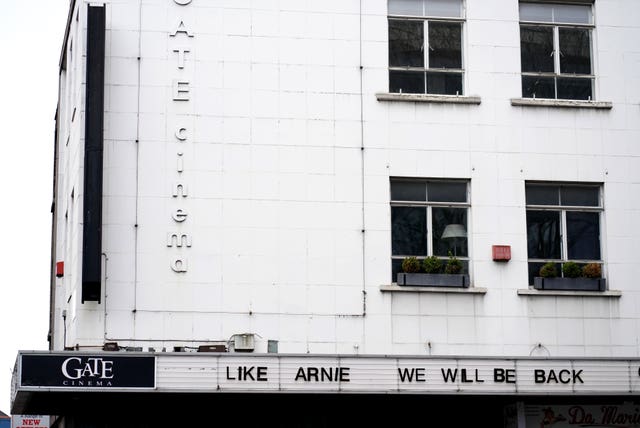
Tom Swarbrick 4pm - 6pm
5 October 2020, 12:14

Here are the answers to key questions surrounding why the company has made this decision and what this means looking forward.
Cineworld workers and investors will feel like they are in a horror movie of their own today, after the cinema giant announced plans to temporarily shut the doors of all its UK and US theatres.
The company said the move will impact up to 45,000 employees across more than 600 cinema sites.
Two weeks ago, the company had told investors that trading had been “encouraging considering the circumstances”.
But now politicians and unions called for “support” for the company’s workforce as their future becomes increasingly uncertain.
Here are the answers to key questions surrounding why the company has made this decision and what this means looking forward:
What are the short-term causes of the closure?
The company’s current troubles partially stem from the impact of the coronavirus outbreak, which forced it to shut sites across the UK and other key markets in March.

Although sites reopened in July, and even earlier in other regions, social distancing rules and a reluctance from studios to release big-ticket films hampered audience figures.
On Monday, Cineworld said that, without these releases, it has been unable to provide UK and US audiences “with the breadth of strong commercial films necessary for them to consider coming back to theatres against the backdrop of Covid-19”.
Major studios, such as Disney, announced heavily-delayed schedules or even pulled some films from cinema release entirely, with Disney opting to release its live-action Mulan film on its own streaming platform instead.
The latest hammer blow was James Bond studios MGM and Universal’s decision to push No Time To Die’s release from November to April 2021.
Mooky Greidinger, chief executive of Cineworld, said it will announce reopening plans when key markets recover and “studios are able to bring their pipeline of major releases back to the big screen”.
What long-term issues have led to this?
Dwindling audience numbers and a thin pipeline of new releases were a particular concern to Cineworld due to long-standing uncertainty in its finances.
The cinema group has grown rapidly in recent years on the back of acquisitions, buying rivals in different regions by lumbering the parent company with significant debts.
In 2018, the company snapped up US chain Regal.
The deal saw Cineworld inherit 535 cinemas, but also 1.6 billion dollars (£1.2bn) in liabilities which AJ Bell investment director Russ Mould said are “now crushing the group”.
Its latest results revealed that it only had a cash balance of 285 million dollars (£220m), compared with around 8.5 billion dollars in debts (£6.6bn), consisting of 4.2 billion in borrowings and 4.3 billion in lease liabilities.
Cineworld’s latest proposed takeover, of Canadian chain Cineplex was its most ill-fated with move after being agreed in December and then collapsing after Cineworld pulled out in the face of the pandemic.

The ensuing costly legal battle with Cineplex continues to rumble on in the backdrop.
Nevertheless, Cineworld is not alone in the sector for sitting on top of significant debt, with Odeon-owner AMC having around five billion dollars (£3.9bn) of debt, even after agreeing to cut its debt-pile by up to 630 million dollars (£486m) in July.
Throughout the coronavirus pandemic, companies saddled with debts have been among the hardest hit, with the likes of Pizza Express and retail property firm Hammerson among those struggling amid hefty debt burdens.
What is the history of the business?
Cineworld was founded by Steve Wiener in the UK in 1995, growing steadily until it was snapped up by private equity giant Blackstone for £120 million in 2004.
The deal resulted in the start of Cineworld’s expensive acquisition spree, with the business snapping up UK rival UGC months later.
Blackstone floated the company on the London stock exchange in 2007, before the company expanded further with the acquisition of the upmarket Picturehouse chain in 2012.
Two years later, the company merged with central and eastern Europe’s biggest cinema group Cinema City but opted to keep the Cineworld name.
The Cinema City chain had been started in 1930 with Armon Theatre in Israel by Moshe Greidinger, the grandfather of the company’s current chief.
Which cinemas and brands are at risk?
The group covers a litany of global brands but is best known in the UK for its core Cineworld, which operates 102 sites across the country.

Its ownership of Picturehouse, which has 25 sites across the UK, also means it owns some of the most recognisable theatres in the UK.
Monday’s damning update casts a shadow over historic sites such as Brixton’s Ritzy theatre, Edinburgh’s 106-year-old Cameo theatre and Brighton’s 110-year-old Duke of York, which are all operated by Picturehouse.
What does this mean for workers?
So far, Cineworld has provided few details over what the temporary closure will mean for staff.
It has said that up to 45,000 employees will be affected by the announcement in the UK and US, with the move particularly perilous as it comes weeks before the end of the Government’s current furlough scheme.
Susannah Streeter, senior investment and markets analyst, Hargreaves Lansdown, said the Chancellor’s latest jobs scheme is unlikely to aid workers impacted by the closures.
She said: “The new jobs support scheme, which will subsidise wages of part time workers will provide no lifeline for the 5,500 Cineworld UK employees who will lose their jobs this week and many others across the industry are facing a bleak winter on jobseekers benefit, while they begin the difficult search for new positions in the run-up to Christmas.”